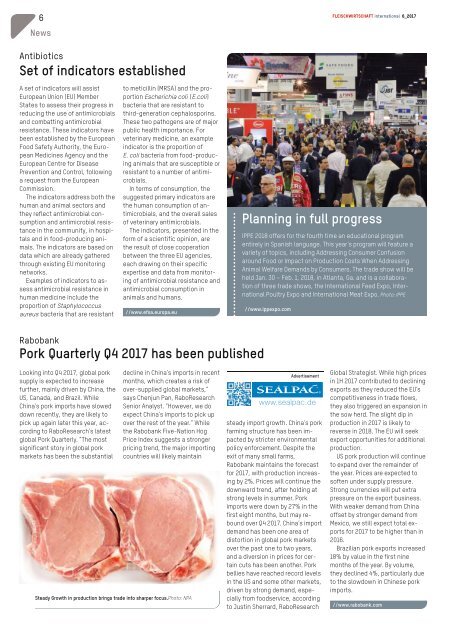FLEISCHWIRTSCHAFT international 6/2017
You also want an ePaper? Increase the reach of your titles
YUMPU automatically turns print PDFs into web optimized ePapers that Google loves.
...............................<br />
6<br />
Fleischwirtschaft <strong>international</strong> 6_<strong>2017</strong><br />
News<br />
Antibiotics<br />
Set of indicators established<br />
Aset of indicators will assist<br />
European Union (EU) Member<br />
States to assess their progress in<br />
reducing the use of antimicrobials<br />
and combatting antimicrobial<br />
resistance. These indicators have<br />
been established by the European<br />
Food Safety Authority, the European<br />
Medicines Agency and the<br />
European Centre for Disease<br />
Prevention and Control, following<br />
arequest from the European<br />
Commission.<br />
The indicators address both the<br />
human and animal sectors and<br />
they reflect antimicrobial consumption<br />
and antimicrobial resistance<br />
in the community, in hospitals<br />
and in food-producing animals.<br />
The indicators are based on<br />
data which are already gathered<br />
through existing EU monitoring<br />
networks.<br />
Examples of indicators to assess<br />
antimicrobial resistance in<br />
human medicine include the<br />
proportion of Staphylococcus<br />
aureus bacteria that are resistant<br />
to meticillin (MRSA) and the proportion<br />
Escherichia coli (E.coli)<br />
bacteria that are resistant to<br />
third-generation cephalosporins.<br />
These two pathogens are of major<br />
public health importance. For<br />
veterinary medicine, an example<br />
indicator is the proportion of<br />
E. coli bacteria from food-producing<br />
animals that are susceptible or<br />
resistant to anumber of antimicrobials.<br />
In terms of consumption, the<br />
suggested primary indicators are<br />
the human consumption of antimicrobials,<br />
and the overall sales<br />
of veterinary antimicrobials.<br />
The indicators, presented in the<br />
form of ascientific opinion, are<br />
the result of close cooperation<br />
between the three EU agencies,<br />
each drawing on their specific<br />
expertise and data from monitoring<br />
of antimicrobial resistance and<br />
antimicrobial consumption in<br />
animals and humans.<br />
//www.efsa.europa.eu<br />
Planning in full progress<br />
IPPE 2018 offers for the fourth time an educational program<br />
entirelyinSpanish language. This year’s program will feature a<br />
variety of topics, including Addressing Consumer Confusion<br />
around Food or Impact on Production Costs When Addressing<br />
Animal Welfare Demands by Consumers. The trade show will be<br />
held Jan. 30 –Feb. 1, 2018,inAtlanta, Ga. and is acollaboration<br />
of three trade shows, the International Feed Expo, International<br />
Poultry Expo and International Meat Expo. Photo: IPPE<br />
//www.ippexpo.com<br />
Rabobank<br />
Pork Quarterly Q4<strong>2017</strong> has been published<br />
Looking into Q4 <strong>2017</strong>,global pork<br />
supplyisexpected to increase<br />
further, mainlydriven by China, the<br />
US, Canada, and Brazil. While<br />
China’spork imports have slowed<br />
down recently, they are likelyto<br />
pick up again later this year, according<br />
to RaboResearch’slatest<br />
global Pork Quarterly. “The most<br />
significant story in global pork<br />
markets has been the substantial<br />
decline in China’simports in recent<br />
months, which creates arisk of<br />
over-supplied global markets,”<br />
says Chenjun Pan, RaboResearch<br />
Senior Analyst. “However, we do<br />
expect China’simports to pick up<br />
over the rest of the year.” While<br />
the Rabobank Five-Nation Hog<br />
Price Index suggests astronger<br />
pricing trend, the major importing<br />
countries will likelymaintain<br />
Steady Growth in production brings trade into sharper focus.Photo: NPA<br />
Advertisement<br />
steady import growth. China’spork<br />
farming structure has been impacted<br />
by stricter environmental<br />
policy enforcement. Despite the<br />
exit of many small farms,<br />
Rabobank maintains the forecast<br />
for <strong>2017</strong>,with production increasing<br />
by 2%. Prices will continue the<br />
downward trend, after holding at<br />
strong levels in summer.Pork<br />
imports were down by 27% in the<br />
first eight months, but may rebound<br />
over Q4 <strong>2017</strong>.China’simport<br />
demand has been one area of<br />
distortion in global pork markets<br />
over the past one to two years,<br />
and adiversion in prices for certain<br />
cuts has been another.Pork<br />
bellies have reached record levels<br />
in the US and some other markets,<br />
driven by strong demand, especiallyfrom<br />
foodservice, according<br />
to Justin Sherrard, RaboResearch<br />
Global Strategist. While high prices<br />
in 1H <strong>2017</strong> contributed to declining<br />
exports as they reduced the EU’s<br />
competitiveness in trade flows,<br />
they also triggered an expansion in<br />
the sow herd. The slight dip in<br />
production in <strong>2017</strong> is likelyto<br />
reverse in 2018.The EU will seek<br />
export opportunities for additional<br />
production.<br />
US pork production will continue<br />
to expand over the remainder of<br />
the year.Prices are expected to<br />
soften under supplypressure.<br />
Strong currencies will put extra<br />
pressure on the export business.<br />
With weaker demand from China<br />
offset by stronger demand from<br />
Mexico, we still expect total exports<br />
for <strong>2017</strong> to be higher than in<br />
2016.<br />
Brazilian pork exports increased<br />
18%byvalue in the first nine<br />
months of the year.Byvolume,<br />
they declined 4%, particularlydue<br />
to the slowdown in Chinese pork<br />
imports.<br />
//www.rabobank.com

















